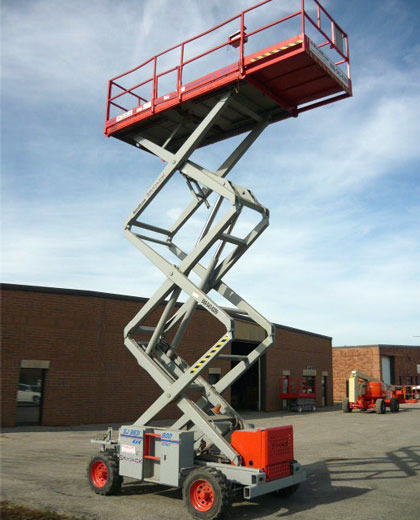Scissor lift
Scissor lifts are a type of aerial work platform (AWP) or mobile elevated work platform (MEWP), used to provide temporary access at height. They are commonly used for temporary maintenance purposes and to undertake construction work. Charles Larson, of the USA, first patented the scissor lift in 1963, but he did not invent it. It was invented by John W Parker of California.
Unlike some other types of elevated platform, scissor lift platforms can only move vertically, elevated by linked, folding supports in an ‘X’ pattern, known as a pantograph. Pressure is applied to the external side of the lowest set of supports, which elongates the criss-crossing supports and raises the platform.
Scissor lifts are usually diesel-powered. The platform be lowered without using the power system, by releasing the hydraulic or pneumatic pressure.
As there are inherent limits in only being able to move vertically, the platform may be fitted with a section that extends outwards to allow closer access to the required work area.
They are typically fitted with wheels allowing them to be relocated.
[edit] Find out more
[edit] Related articles on Designing Buildings Wiki
- Cherry picker.
- Construction plant.
- Construction tools.
- Forklift truck.
- Hoist.
- Lift table.
- Lifting device.
- Lifting platform.
- Mobile elevating work platforms (MEWPs).
- Post lift.
- Scaffolding.
- Stacker.
- Types of crane.
- Work at height.
- Working platform.
- Working platforms for tracked plant: good practice guide to the design, installation, maintenance and repair of ground-supported working platforms.
Featured articles and news
RTPI leader to become new CIOB Chief Executive Officer
Dr Victoria Hills MRTPI, FICE to take over after Caroline Gumble’s departure.
Social and affordable housing, a long term plan for delivery
The “Delivering a Decade of Renewal for Social and Affordable Housing” strategy sets out future path.
A change to adoptive architecture
Effects of global weather warming on architectural detailing, material choice and human interaction.
The proposed publicly owned and backed subsidiary of Homes England, to facilitate new homes.
How big is the problem and what can we do to mitigate the effects?
Overheating guidance and tools for building designers
A number of cool guides to help with the heat.
The UK's Modern Industrial Strategy: A 10 year plan
Previous consultation criticism, current key elements and general support with some persisting reservations.
Building Safety Regulator reforms
New roles, new staff and a new fast track service pave the way for a single construction regulator.
Architectural Technologist CPDs and Communications
CIAT CPD… and how you can do it!
Cooling centres and cool spaces
Managing extreme heat in cities by directing the public to places for heat stress relief and water sources.
Winter gardens: A brief history and warm variations
Extending the season with glass in different forms and terms.
Restoring Great Yarmouth's Winter Gardens
Transforming one of the least sustainable constructions imaginable.
Construction Skills Mission Board launch sector drive
Newly formed government and industry collaboration set strategy for recruiting an additional 100,000 construction workers a year.
New Architects Code comes into effect in September 2025
ARB Architects Code of Conduct and Practice available with ongoing consultation regarding guidance.
Welsh Skills Body (Medr) launches ambitious plan
The new skills body brings together funding and regulation of tertiary education and research for the devolved nation.
Paul Gandy FCIOB announced as next CIOB President
Former Tilbury Douglas CEO takes helm.
UK Infrastructure: A 10 Year Strategy. In brief with reactions
With the National Infrastructure and Service Transformation Authority (NISTA).























